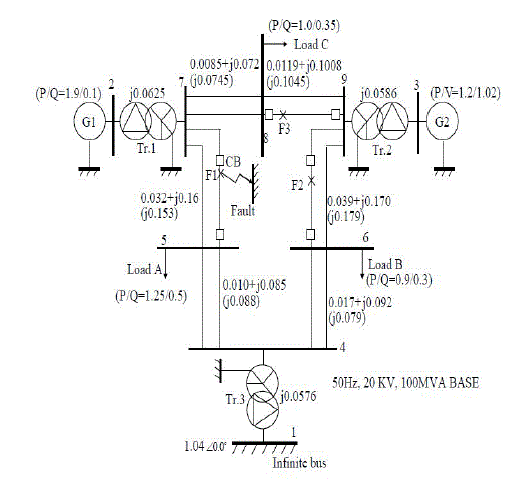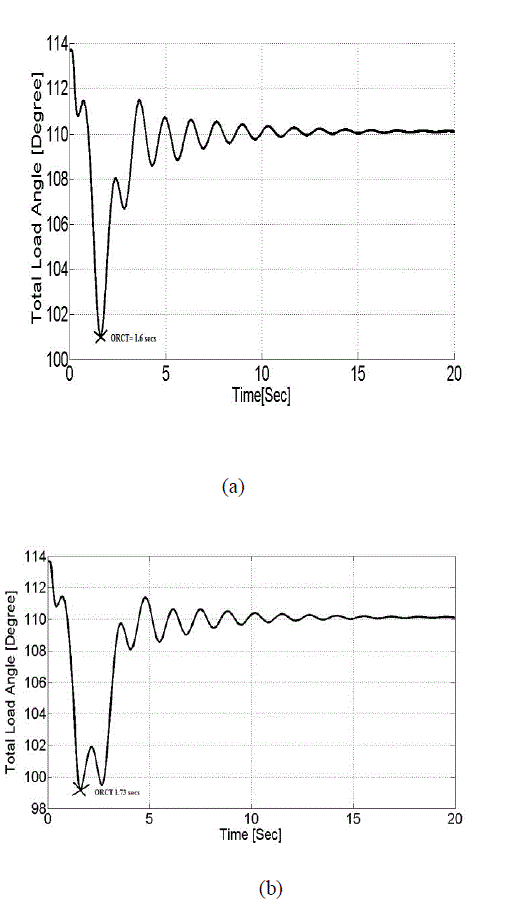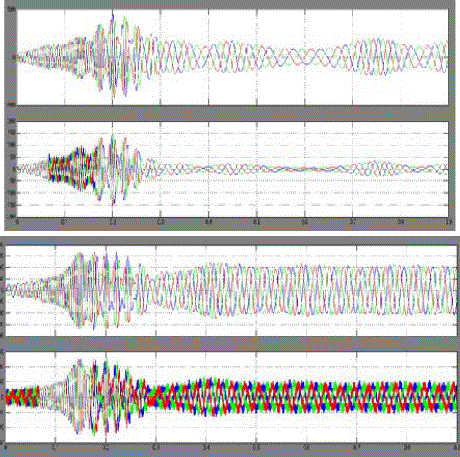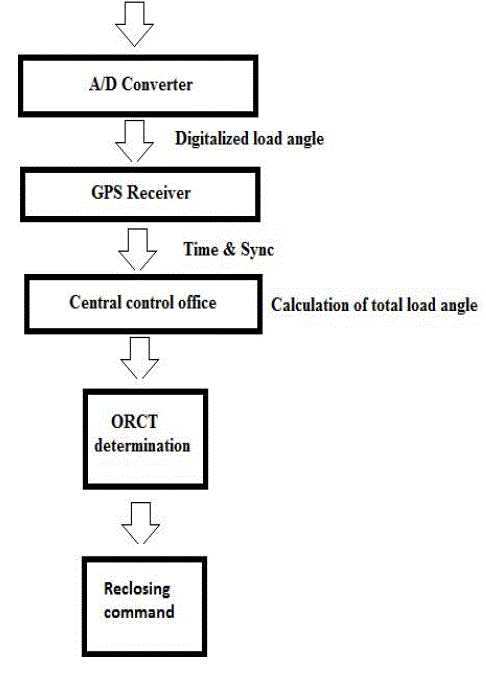INTRODUCTION
|
| It is well known that, in a power system, auto-reclosing schemes are widely applied on high-voltage transmission lines. It is well realized that the transient faults which are frequent in occurrence do not cause permanent damage to the system, as they are transitory in nature. These faults disappear if the line is disconnected from the system momentarily in order to allow the arc to extinguish. The line can be reclosed only after the arc path has become de ionized to restore normal service |
| If there is a permanent fault, reclosing makes no difference as the fault still persists. It shows that nearly 80% of the faults are cleared after the first trip, 10% stay in for the second reclosure which is made after a time delay, 3% require the third reclosure and about 7% are permanent faults which are not cleared and result in lockout of the reclosing relay. |
| The common practice is to reclose the circuit breakers automatically to improve service continuity. The reclosure may be either high-speed or with time delay. High-speed reclosure refers to the closing of circuit breakers after a time just long enough to permit fault-arc de-ionization. The reclosure can be completed in less than 1 second .However, high-speed reclosure is not always acceptable. Reclosure into a permanent fault i.e. unsuccessful reclosure may cause system instability and may deteriorate power quality. Thus, the application of automatic reclosing is usually constrained by the possibility of a persistent fault, which would create a second fault after reclosure. |
| Conventional auto-reclosing techniques adopt fixed time interval reclosing, that is, the circuit breakers reclose after a prescribed dead time which is set to a constant value . Since the transient stability is dependent on the generator state of reclosing instance, in some cases, conventional method may cause an unstable state, especially for the case of unsuccessful reclosing. Therefore, in order to maintain the synchronism and power quality, and enhance the transient stability, the circuit breakers should be reclosed at optimal reclosing time (ORCT) where system disturbances after reclosing operation are restrained effectively. |
| In literatures, different types of reclosing techniques are reported, such as the Variable dead time control method, Total kinetic energy method , Adaptive reclosing algorithm considering distributed generation, Transient energy function method and Neural-network based adaptive single–pole autoreclosure Variable dead time auto reclosing using artificial neural network,. The aim of all of these methods is to determine the ORCT. With this background, this paper proposes a new method of optimal reclosing based on the total load angles of the synchronous generators in the system in accordance with the STATCOM. The performance of the proposed reclosing method is compared with that of the conventional reclosing technique. Two indices are used to evaluate the power quality of the system. The indices are speed and voltage .In order to analyze the transient stability issues a Facts device Static Var Compensator STATCOM is considered. In order to analyze the optimal reclosing technique, the IEEE nine bus power system model is considered. Both balanced and unbalanced temporary and permanent faults at different locations of the system are considered. Simulations are performed through Matlab/Simulink software. |
II. DESCRIPTION OF MODEL SYSTEM
|
| For the analysis of optimal reclosing techniques, the IEEE nine bus power system model shown in Fig. 1 is used. The model system consists of two synchronous generators (G1 and G2) with capacities of 200 MVA and 130 MVA, respectively, and an infinite bus are considered . Generators are connected to one another through transformers and double circuit transmission lines. The line parameters have the form R+jX(jB/2), where R, X and B represent resistance, reactance and susceptance, respectively, per phase with two lines,. F1, F2 and F3 are considered as the fault positions. Parameters of Generator 1 and Generator 2 have been shown in Table I. |
III. LOAD ANGLE BASED OPTIMAL RECLPOSING TECHNIQUES
|
| Conventional auto-reclosing of circuit breakers can affect the stability and power quality of the system, as it is dependent on the generator state of reclosing instances. So, to enhance the transient stability and power quality, circuit breakers should be closed at an optimal reclosing time, when the system disturbance has no effect after reclosing operation. |
| The optimal reclosing time is considered as the point which meets the following conditions: |
| i) The point when the total load angles oscillation of the generators without reclosing operation becomes the minimum |
| ii) The value obtained from condition I must be greater than the reclosing time, Tr, as shown below: |
| Tr = (10.5+ KV/34.5) cycles (1) |
| where KV indicates the line-to-line rms voltage of the system. |
| In the load angle method, the load angles of both the generators, G1 and G2, are considered. The sum of the load angles are considered to find the ORCT. In this method, the optimal reclosing time is considered as the point when the total load angles oscillation of the generators without reclosing operation becomes the minimum. |
| Figure 2 shows the total load angles response for the 3LG (three phase-to-ground) and 1LG (single phase-to-ground fault) temporary and permanent faults without reclosing operation to find out the optimal reclosing times. |
| Using this technique, the values of ORCT of different fault positions for temporary and permanent faults are calculated from the total load angles responses and represented in the Tables II and III, respectively. In this case also, the ORCT values are certainly bigger than the Tr value in order to allow for the arc to extinguish. |
IV. SIMULATION RESULTS AND DISCUSSIONS
|
| In this work, simulations are performed through Matlab/Simulink software. In order to demonstrate the effectiveness of the proposed reclosing technique, simulations have been carried out considering both balanced (3LG) and unbalanced (1LG) temporary and permanent faults. F1, F2 and F3 are considered as the fault locations in the system model of Figure 1. The simulation time and time step are considered as 20sec and 50 μs, respectively. |
| It is assumed that the fault occurs at 0.1sec, the circuit breaker opens at 0.2sec, and the circuit breaker recloses at 1.0 sec in case of the conventional reclosing. However, in case of the proposed reclosing technique, the circuit breaker recloses at the ORCT values as shown in Tables II and III. In case of permanent faults, the circuit breakers reopen after 0.1sec of the reclosing instances |
| The performance of the reclosing method is evaluated in terms of the voltage index, and also in terms of speed index, Sindex,. The lower the value of the indices, the better the system’s performance and with that STATCOM is coordinated with the total load angles based optimal reclosing method for transient stability and power quality. |
A. Performance of the Proposed Technique
|
| The indices for the conventional and total load angles based optimal reclosing methods in case of both temporary and permanent 3LG and 1LG faults at points F1, F2 and F3 are considered. |
| From the indices and responses it is evident that on integrating the STATCOM in total load angles based reclosing method the system performs better than the conventional method. |
V. PRACTICALITY OF THE OPTIMAL RECLOSING METHOD
|
| One question might arise here regarding the practical implementation of the proposed optimal reclosing method. However, it is hoped that the proposed method can be implemented in real time. The required signal needed to be captured for the total load angles based method is the load angles of the generators. The online measurement of the load angle of different generators located at different locations and then calculation of the total load angles can be done through the global positioning system (GPS). |
| Fig. 4 shows the functional block diagram of GPS, where the GPS receiver receives the digitalized speed/angle/voltage signals collected from the generators, and makes them both time and phase synchronized. Using the computers, the central control office then can determine the ORCT easily |
VI. CONCLUSION
|
| This paper proposes a new method of optimal reclosing based on the total load angles of the synchronous generators in coordination of an auxiliary control such as STATCOM in the system. The performance of the proposed reclosing method is compared with that of the conventional reclosing technique. Both balanced and unbalanced temporary and permanent faults at different locations in the power system model are considered. From the simulation results, the following points are noteworthy. |
| a) The proposed total load angles based optimal reclosing technique is effective to maintain the power quality in a multi-machine power system. |
| b) The performance of the proposed reclosing method is better than that of the conventional reclosing method. |
| In future work, we would involve optimization such as fuzzy control, neural networks, genetic algorithm, etc., for better power quality and transient stability. |
Tables at a glance
|
|
|
| |
Figures at a glance
|
 |
 |
 |
 |
| Figure 1 |
Figure 2 |
Figure 3 |
Figure 4 |
|
| |
References
|
- Sunil S Rao, Switchgear Protection and Power System. KhannaPublishers, 2010.
- P. Kundur, Power System Stability and Control. McGraw-Hill, Inc.,1994.
- B. H. Zhang , Z. Q. Bo, Y. Z. Ge, R. K. Aggarwal, and A. T. Johns, “Thedesign and application of an optimal reclosure technique for transmissionlines,” 1995 North American Power Symposium, Montana StateUniversity, Bozeman, MT, USA, pp. 415-421, 1995.
- M. Yagami, T. Murata, and J. Tamura, "An analysis of optimalreclosing for enhancement of transient stability", Electrical Engineering inJapan, vol. 147, no. 3, pp. 32-39, 2004.
- S.-P. Ahn, C.-H. Kim, R. K. Aggarwal and A. T. Johns, “An alternativeapproach to adaptive single pole auto-reclosing in high voltagetransmission systems based on variable dead time control,” IEEE Trans.Power Delivery, vol. 16, no. 4, Oct. 2001, pp. 676-686
- I.-D. Kim, H.-S. Cho, J.-K. Park, “A variable dead time circuit breakerauto-reclosing scheme using artificial neural networks,” Electrical Powerand Energy Systems, vol. 21, pp. 269-277, 1999.
- H. –C. Seo and C. –H. Kim,” An adaptive reclosing algorithmconsidering distributed generation,” International Journal of Control,Automation, and Systems, vol. 6, no. 5, pp. 651-659, Oct. 2008.
- Z.Q. Bo, R.K. Aggarwal, A. T. Johns, B. H. Zhang and Y.Z. Ge, “Newconcept in transmission line reclosure using high- frequency faulttransients,” Proc. Inst. Elect. Eng., Gen., Transm.,Distri.,, vol.144, no. 4,pp.351-356, Jul. 1997.
- Y. Yuchun, Z. Baohui and W. Qingfang,” A method for capturingoptimal reclosing time of Transient Fault,” In Proc. IEEE InternationalConf. on Power Sys. Technology, POWERCON 1998, vol. 2, pp. 1138-1142.
- B. H. Zhang, Y. C. Yuan, Z. Chen, and Z. Q. Bo,” Computation ofoptimal reclosure time for transmission lines,” IEEE Trans. Power Sys.,vol. 17, no. 3,pp. 670-675, August 2002.
- R. K. Aggarwal, A. T. Johns, Y. H. Song, R. W. Dunn, and D. S.Fitton, “Neural-network based adaptive single-pole autoreclosuretechnique for EHV transmission systems,” IEE Proc.-Gener. Transm.Distrib.,vol. 141, no. 2, pp. 155-160, March 1994.
- M. H. Ali, T. Murata, and J. Tamura,” Effect of Coordination ofOptimal Reclosing and Fuzzy Controlled Braking Resistor on Transient Stability During Unsuccessful Reclosing,” IEEE Trans. Power Sys., vol.21, no. 3, pp. 1321-1329 , August 2006.
- Working Group H-8 of the relay Communications Subcommittee ofthe IEEE Power System Relaying Committee, “IEEE standard forsynchrophasors for power systems,” IEEE Trans. Power Del., vol. 13, no. 1, pp. 73-77, Jan 1998.
- H.Y. Li, E.P. Southern, P.A. Crossley, S. Potts, S.D.A. Pckering,B.R.J. Caunce, and G.C. Weller ,“ A new type of differential feederprotection relay using the global positioning system for datasynchronization ,” IEEE Trans. Power Del., vol. 12, no. 3, pp. 73-77, Jul1997.
- Working Group H-7 of the Relaying Channels Subcommittee of theIEEE Power System Relaying Committee, “ Synchronized sampling andphasor measurements for relaying and control,” IEEE Trans. Power Del.,vol. 9, no. 1, pp. 442-452, Jan 1994.
- R.O. Burnett Jr., M.M. Butts, T.W. Cease, V. Centeno, G. Michale,R.J. Murphy and A.G. Phadke,“ Synchronized phasor measurements of apower system event,” IEEE Trans. Power Del., vol. 9, no. 3, pp. 1643-1650, Aug 1994.
- Teleke, S. ;Yazdani, A. ; Gudimetla, B. ; Enslin, J. ;Castaneda,J.“Application of STATCOM for power quality improvementPower Systems Conference and Exposition (PSCE), 2011IEEE/PES Publication Year: 2011 .
|